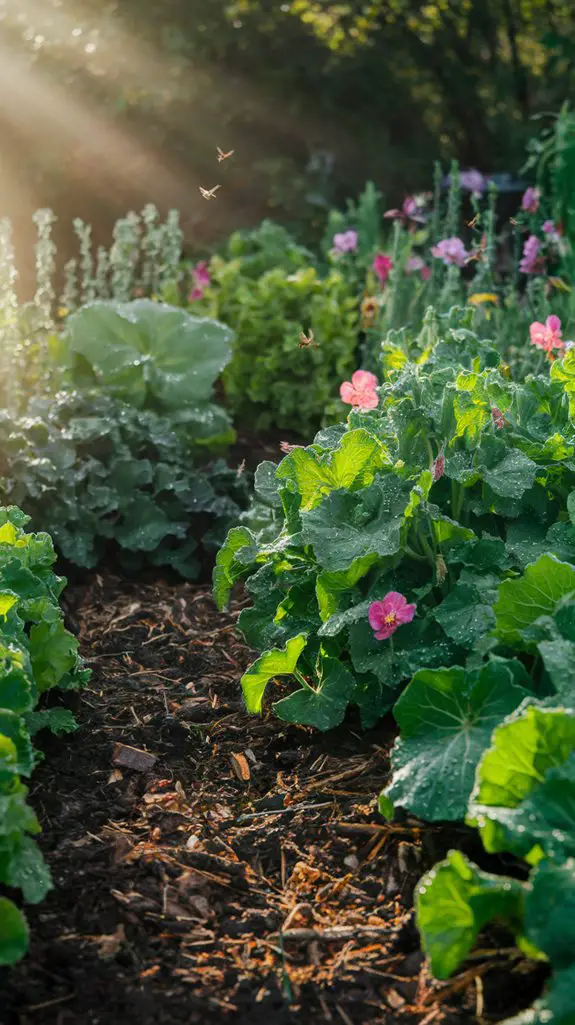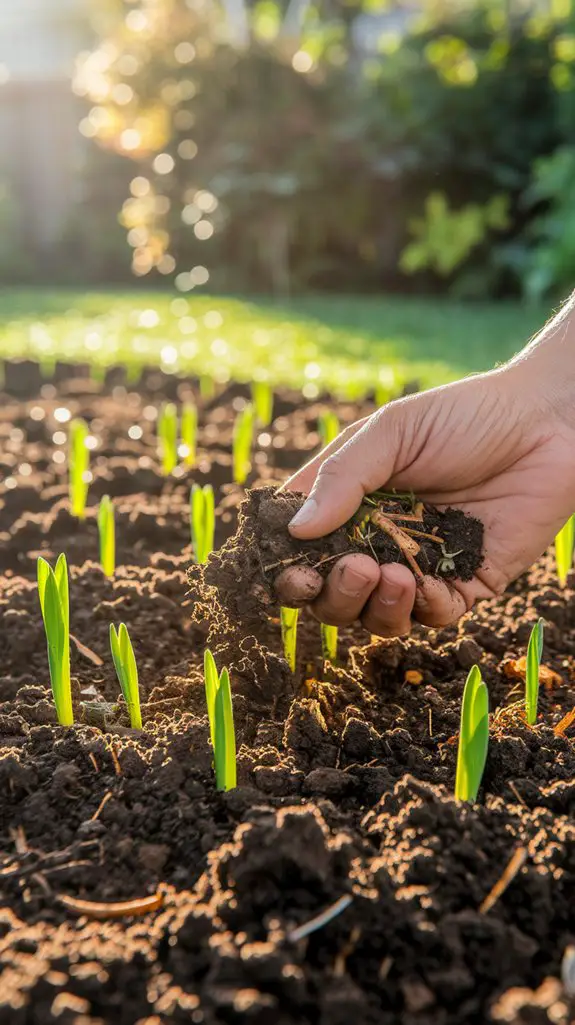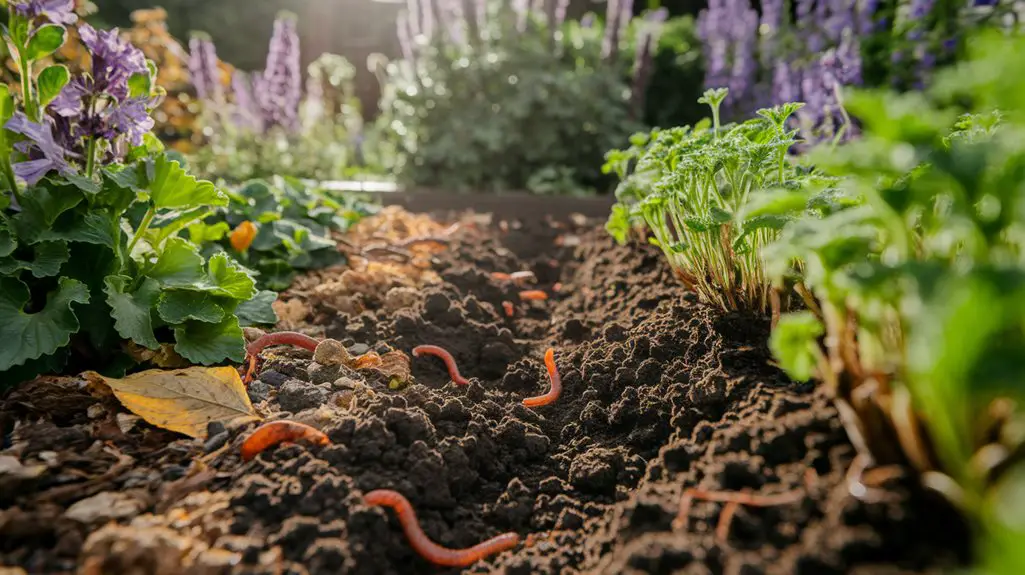Did you know that healthy soil contains over 1 billion microorganisms in just a teaspoon? When you add organic materials to your backyard soil, you’re creating a thriving ecosystem beneath your feet. These natural amendments improve structure, enhance water retention, and supply essential nutrients without harmful chemicals. Your plants develop stronger root systems and greater resistance to pests. The benefits extend beyond your garden, contributing to a healthier planet for generations to come.
The Environmental Benefits of Organic Soil Amendment
When you enrich your soil with organic amendments, you’re participating in one of nature’s most elegant cycles of renewal and regeneration. Your actions help sequester carbon, reducing greenhouse gases that contribute to climate change.
Organic materials create resilient soil ecosystems that naturally resist pests and diseases without chemical interventions. You’ll conserve water too, as amended soil retains moisture more effectively, reducing runoff and erosion while protecting local waterways from pollution.
The biodiversity below ground explodes when you introduce organic matter. Earthworms, beneficial microbes, and fungi form intricate networks that break down nutrients and make them available to plants. Additionally, raised garden beds can enhance the benefits of organic soil amendments by providing better drainage and warmer soil temperatures.
This living soil web reduces your dependence on synthetic fertilizers that can harm the environment when they leach into groundwater.
Your garden becomes a microhabitat supporting nature’s balance.
Top Organic Materials for Nutrient-Rich Garden Soil

Creating magnificent garden soil starts with selecting the right organic amendments, each offering unique benefits to your growing environment.
Compost reigns supreme, teeming with microorganisms that enhance soil structure while providing slow-release nutrients. Aged manure adds nitrogen and organic matter, but make certain it’s well-composted to prevent burning plants.
Leaf mold improves moisture retention and creates fungal-rich habitats beneficial for perennials.
Don’t overlook coffee grounds for acid-loving plants and earthworm attraction, or pine needles for acid adjustment and mulching.
Seaweed delivers trace minerals and natural growth hormones, while biochar sequesters carbon and creates permanent micropores for beneficial microbes.
Wood chips, excellent for pathways and mulch, decompose slowly to feed soil life continuously.
Each material builds your soil’s living ecosystem differently, supporting plants naturally. Additionally, using raised garden beds can further enhance your organic gardening experience by improving drainage and soil quality.
How Organic Matter Improves Soil Structure and Drainage

Although invisible to the naked eye, the transformation organic matter triggers in garden soil rivals nature’s most impressive feats. When you incorporate compost, leaf mold, or aged manure into your garden, you’re creating a living ecosystem beneath your feet. Organic mulch options, such as eco-friendly mulch, can further enhance this process by providing additional nutrients and improving soil health.
| Soil Change | Organic Matter Benefit |
|---|---|
| Structure | Creates soil aggregates for root penetration |
| Porosity | Increases air pockets for oxygen flow |
| Drainage | Prevents waterlogging while retaining moisture |
| Compaction | Loosens clay soils, preventing hardpan |
| Erosion | Binds soil particles, reducing runoff |
Organic matter works like a living sponge, absorbing excess water during downpours and releasing it during dry periods. You’ll notice your shovel slides more easily through soil rich with decomposed organics, as the intricate network of humus transforms even stubborn clay into crumbly, workable earth.
Composting Basics: Converting Kitchen Waste Into Garden Gold
If you’ve ever discarded banana peels or coffee grounds, you’ve missed an opportunity to create nature’s most perfect soil amendment. Composting transforms your kitchen scraps into nutrient-rich humus through the work of microorganisms that break down organic matter.
Start by collecting fruit and vegetable scraps, eggshells, coffee grounds, and tea bags in a dedicated kitchen container. Avoid meat, dairy, and oils that attract pests.
Layer these “greens” with “browns” like dried leaves, cardboard, or newspaper in your outdoor compost bin, maintaining a 3:1 brown-to-green ratio.
Turn your pile every few weeks to aerate it and add water when it feels dry. In 3-6 months, you’ll harvest dark, crumbly compost that feeds soil life, improves structure, and reduces landfill waste—all from materials you’d otherwise throw away. Additionally, incorporating renewable resources into your compost can enhance the nutrient profile of your soil.
Mulching With Natural Materials to Protect Your Soil
While garden soil thrives beneath a protective blanket, bare earth suffers from erosion, water loss, and temperature extremes.
Natural mulching materials—straw, leaves, grass clippings, or wood chips—create a living shield for your soil ecosystem. Apply a 2-3 inch layer around plants, keeping it pulled back slightly from stems and trunks.
You’ll notice immediate benefits: moisture retention during hot spells, temperature regulation that protects delicate soil life, and gradual decomposition that feeds your soil web. Additionally, using organic materials in your garden can significantly enhance soil structure and fertility.
As these materials break down, they contribute organic matter directly to your topsoil.
Choose locally available materials when possible. Autumn leaves make excellent free mulch, while pine needles work well for acid-loving plants.
Even shredded newspaper or cardboard can serve as effective biodegradable protection for your garden’s most valuable asset—its soil.
The Long-Term Sustainability of Organic Soil Practices
When gardeners commit to organic soil practices, they’re investing in Earth’s future, not just next season’s harvest. You’ll find that replenishing your soil naturally creates a self-sustaining ecosystem that improves year after year, unlike chemical fertilizers that deplete soil structure over time.
| Timeframe | Chemical Approach | Organic Approach |
|---|---|---|
| Year 1 | Quick results | Slow improvement |
| Year 5 | Depleted soil | Rich microbiome |
| Year 10 | Dependent system | Self-sustaining |
Your garden becomes a carbon sink when you build organic matter, sequestering atmospheric carbon dioxide into the soil. This climate-conscious approach transforms your backyard into an environmental ally. The legacy you’re creating extends beyond your property lines, contributing to watershed health, biodiversity, and ecological resilience for generations to come. Additionally, utilizing natural solutions for pest control can further enhance the health of your garden ecosystem.
Chemical-Free Alternatives for Common Garden Problems
Garden pests and diseases need not trigger a chemical response when your soil ecosystem is properly balanced. You’ll find that rich organic soils naturally suppress many common problems by fostering beneficial microorganisms that keep pathogens in check. For aphids, introduce ladybugs or spray plants with a diluted neem oil solution. Combat fungal issues with compost tea applications that boost your soil’s immune system. Slugs retreat from crushed eggshell barriers, while companion planting—marigolds near tomatoes or nasturtiums alongside cucumbers—naturally deters numerous pests. Weeds signal soil imbalances; address them by maintaining proper mulch layers and encouraging dense plant growth. Additionally, understanding natural pest control strategies can further enhance your garden’s resilience against pests and diseases.
Seasonal Guide to Applying Organic Materials in Your Backyard
The rhythm of nature provides a perfect calendar for organic soil building throughout the year.
Spring calls for applying compost as beds warm, working in light applications of well-rotted manure before planting.
Summer requires mulching with grass clippings or straw to retain moisture and suppress weeds while gradually breaking down into the soil.
Fall presents the year’s greatest opportunity—layer fallen leaves directly onto beds or compost them first.
Winter isn’t dormant time but decomposition time; apply a layer of cardboard or newspaper topped with organic matter, letting winter moisture and freezing cycles break materials down.
Coffee grounds work year-round as a nitrogen boost. Maintaining raised garden beds is essential for achieving optimal soil health and productivity.
Remember that timing matters—fresh manures can burn plants if applied during growing seasons, while wood chips need months to decompose before planting.
Conclusion
Your garden sits at a crossroads: synthetic chemicals that deplete while promising abundance, or living organics that nourish while building legacy. You’re not just growing plants—you’re cultivating life below ground. As your hands work compost into tired soil, microscopic civilizations flourish. What you choose today determines tomorrow’s inheritance. Let your backyard become both canvas and sanctuary, where earth’s natural cycles continue unbroken through your stewardship.




